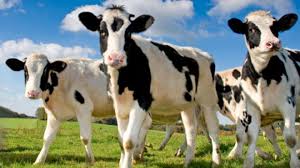|
Research Title /
Graphical Abstract
|
Article Information /
Abstract
|
Download
|
|
Effect of dietary levels of cowpea (Vigna unguiculata) seeds on broiler performance and some serum biochemical factors
 
|
Original Research, D1
pii: S222877011400001-4
Gumaa Balaiel. N.
Online J. Anim. Feed Res., 4(1): 01-05, 2014.
ABSTRACT: Effect of inclusion of different levels of untreated cowpea (Vigna unguiculata) seeds (0, 5, 10 and 15%) in broiler diet on performance and some serum biochemical factors was studied. The research was conducted on basis of a completely Randomized Design (CRD). Feed intake, body weight gain, feed conversion ratio, protein intake and protein efficiency ratio were significantly (P<0.05) reduced with the inclusion of 15% untreated cowpea seeds. Plasma cholesterol, glucose, albumin, total protein, Ca and K contents were significantly (P<0.05) decreased with increasing level of cowpea seeds in diets. Uric acid concentration observed to be higher in birds fed 15% cowpea seed. It is concluded that good performance of broiler chicken is satisfactory maintained with 5 to 10% inclusion of cowpea seeds in balanced diet for broiler.
Key words: Cowpea, Untreated, Broiler, Production, Plasma
|


|
|
Nitrogen balance and rumen microbial protein synthesis in goats fed diets containing soaked and roasted Mucuna bean (Mucuna pruriens)
 
|
Original Research, D2
pii: S222877011400002-4
Mbewe M. R. Hamandishe V. R. Imbayarwo-Chikosi V. E.And B. Masunda.
Online J. Anim. Feed Res., 4(1): 06-09, 2014.
ABSTRACT: The effect of soaking and roasting velvet beans (Mucuna pruriens) on nitrogen utilization and rumen microbial protein synthesis in goats was investigated. Sixteen goats were randomly assigned to four diets in a completely randomized design. Goats were fed a basal diet of Cynodon dactylon hay plus 30% soaked (treatment 1), 30% roasted (treatment 2) and 30% untreated velvet bean (treatment 3). The control diet had 100% hay (treatment 4). Animals were given experimental diets over 14 days following a 7-day adjustment period. Feed, refusals, urine and faecal samples were collected daily from individual goats for determination of nitrogen, nitrogen intake, utilization and allantoin in faeces and urine. Microbial protein yield was estimated from the allantoin. Data were analysed using PROC General Linear Model of Statistical Analysis Software. Goats fed a diet with soaked beans had significantly higher (P<0.05) nitrogen balance than those fed diets with roasted beans although nitrogen balance for the latter was non-significantly different (P>0.05) from that of goats fed untreated beans. Microbial protein synthesis was highest for diets with soaked beans although this was non-significantly different (P>0.05) from diets with roasted and untreated beans. All diets containing velvet beans, processed or not, contributed to significantly higher (P<0.05) microbial protein yield than diets with hay only. In terms of nitrogen balance, soaking can be recommended as an appropriate processing method for velvet beans for goat feeding. However, for microbial protein yield, processing method was not statistically important and the bean could be used untreated producing the same results.
Key words: Velvet Beans, Goats, Nitrogen Balance, Microbial Protein
|


|
|
Cassava (manihot esculenta crantz): an affordable energy source in dairy rations
 
|
Original Research, D3
pii: S222877011400003-4
Anjos F.R., Tivana L., da Cruz Francisco J. and Kagande S.M.
Online J. Anim. Feed Res., 4(1): 10-14, 2014.
ABSTRACT: The current paper explores the evidence that exists on the potential use of cassava plant (Manihot esculenta Crantz) as an energy source for dairy cattle. Several studies have proven cassava roots, leaves and processing residues to be an important ruminant animal feed resource. Cassava root chip and meal are a potentially good rumen fermentable energy for dairy cows in the tropics. The vegetative parts of cassava are considered to be wastes since human beings grow cassava for its tubers. Feeding trials with cattle have shown cassava hay to have a dry matter intake levels DMI of around 3.2% of BW) and a digestibility (71%). The hay also contains tannin-protein complexes that may be a good source of rumen un-degradable protein that will be available to the animal post-ruminally. It has also be shown that supplementing 1-2 kg/head/day of cassava to dairy cattle may go a long way in reducing feeding costs and significantly increasing milk quality and quantity produced. Cassava hay was also noted to be anthelminthic and therapeutic since it contains condensed tannins. Condensed tannins have been proven to reduce gastrointestinal nematodes. Use of cassava as a substitute of maize in dairy rations can significantly lower the feed costs in smallholder dairy farms in cassava producing countries like Mozambique. It was concluded that cassava is potentially an affordable substitute for conventional energy source for small scale dairy farmers.
Key words: Cassava, Feed, Commercial Opportunity, Dairy, Cattle
|


|
|
Aerobic bacteria and fungi associated with raw camel’s milk

|
Original Research, D4
pii: S222877011400004-4
Elhaj, A.E., Freigoun, Somaya, A.B. and Mohamed, T.T.
Online J. Anim. Feed Res., 4(1): 15-17, 2014.
ABSTRACT: The objective of this study was to determine the aerobic bacteria and fungi associated with raw camel’s milk. Samples were collected from farms in Bahri (Khartoun North) area in the Sudan. The isolated aerobic bacteria (one hundred and fifteen isolates) were identified as (85.26%) Gram–negative, while (14.73%) were Gram-positive. The Gram-negative bacteria were 39.13% Escherichia coli serotypes, 07.82% Klebsiella spp., 01.73% Psedomonas spp., 03.47% Proteues spp. and 06.08% Enterococci spp. While, the Gram-positive bacteria were 07.82% Micrococcus spp., 05.21% Streptococcus spp. and 28.69% Staphylococcus spp. In conclusion camel milk is a source for many bacteria which may lead to health hazard for man when it is taken raw (as in many rural areas in Arabic countries including the Sudan).
Key words: Raw Camel Milk, Aerobice Bacteria, Fungi.
|


|
|
|
|
|
|
|
|
|
|
|
|
|
|
|
|
|
|
|
|
|
|
|
|
|
|
|
|
|
|
|
|
|
|

